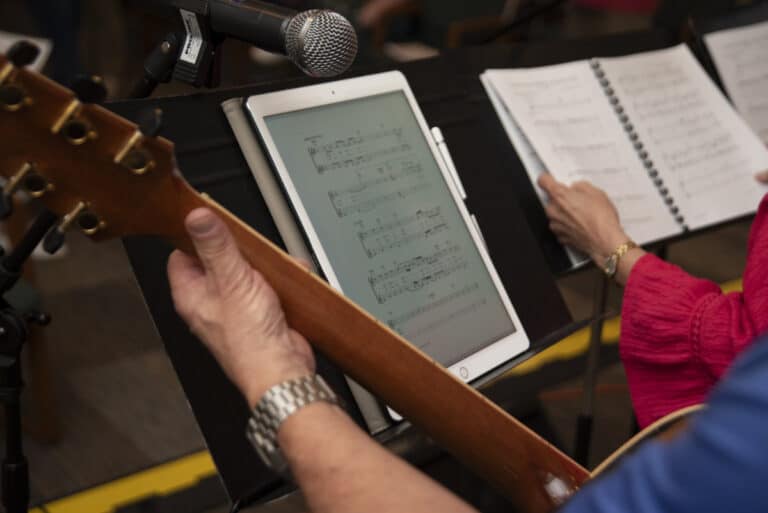A cappella singing in liturgy can be an effective tool that ensemble music directors can use to enrich a worship experience.
While there are times that a full piece may be sung a cappella, this article focuses on how ensembles can use moments of a cappella music for emphasis and impact. For example, using full instrumentation for a song but then transitioning to voices alone for a full or partial final refrain or a single verse.
Ensemble directors should never underestimate the impact of breaking into a cappella singing at the end of a piece as a powerful means of unifying the gathered community.
Options for using a cappella singing in liturgy
Coordinating a cappella singing in this manner is rather simple with a little bit of planning. Sometimes a final refrain can be easily repeated without instruments. This works well on the piece “How Can I Keep from Singing.”
Another idea is to sing the final refrain a cappella coming right out of the verse. Selections such as “Let Justice Roll Like a River,” “Belong,” or “Drawn to You” are perfect for singing the last refrain without instruments. For songs with verses only, the entire final verse can be sung with voices alone. “Amazing Grace” is a great choice for an a cappella final refrain.
Musical considerations
When using a cappella singing to add emphasis to a song, there are a couple of musical issues that need to be considered. First, all instrumentalists must know in advance when to stop playing. Communication between instrumentalists is of utmost importance, whether the decision is made before the song begins or while it’s being played.
In addition, instead of having all instruments tacet on the downbeat of the a cappella section, all instruments should strike the first chord of the section and let it ring until the next chord-change in the music. Keeping the first chord ringing adds a great effect to the sudden change. While the break to voices alone is meant to grab attention, the sustaining chord allows the transition to not be too jarring as the instruments fade out.
Finally, directors may choose to have the instruments re-enter the song, perhaps on the final phrase. This would work well on “How Can I Keep from Singing” as the return of instruments can help the voices maintain pitch through the final ending.
The impact of a cappella singing
We know that the sound of the human voice is most coveted in our worship, and encouraging and supporting the sound of the singing assembly should be our highest goal. Giving the assembly a chance to hear their own voices without the use of instruments, especially when it’s unexpected, can have a profound effect on our worship.
Assemblies take ownership when they hear their own voice. They become more confident, and thus, more willing to sing. Remember, this is our aim above all else — the full, conscious, and active participation of the faithful. If occasionally breaking into an a cappella refrain at the end of a song will help the gathered faithful find their voice, we should then be inclined to work this element into our worship.
There are many creative options for using a cappella singing in liturgy, so try some different options in rehearsal and see what works for your ensemble. When done well and with intention, a cappella singing can be a powerful moment within liturgy.
Written by Steve Petrunak, a founding board member of CLEF and director of music at St. Blase Catholic Church in Sterling Heights, Michigan.
Copyright © 2023 Catholic Liturgical Ensemble Formation



